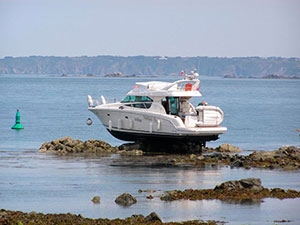Sooner or later, if you use your boat, you will have an unexpected encounter with the bottom. Just knowing that it happens to everyone can help, preventing you from doing something rash to save face in the heat of the moment. So, after the intial “Oh #!*&@!” what should you do?
- Don’t panic. Check if anyone has been injured, and then check for damage to the hull, especially taking on water. Whether you’re freed quickly or not, anytime your boat bumps bottom, check the bilge for rising water. Inspect rudder and shaft stuffing boxes, and on sailboats, the keel bolts. If the boat is leaking badly, man the pumps and call for assistance immediately. Even if the bilge seems dry initially, keep checking periodically to make certain it’s still dry.
- Determine exactly what you’re aground on – sand, mud, rocks, coral, etc. – and where deeper water might be.
- Check the tide tables to determine the next high tide.
- Don’t attempt to back off without assessing the situation thoroughly. Accelerating in reverse could cause more damage and put you harder aground. The boat’s engine gets its cooling water from somewhere under the boat, and if it sucks up enough mud or sand, the engine could be ruined. This could also damage or tear off the boat’s running gear. Shut the engine down until you’ve ascertained how far the intake is from the bottom.
- If you were moving slowly when you grounded and hull damage looks to be minimal, you may be able to simply back off by shifting the weight farthest from the point of impact and using an oar or boat hook to push off. As you start to move, be sure to check once again to make sure you are not taking on water from a hole caused by the grounding.
- Try to reduce draft by emptying water tanks, moving heavy gear into a dinghy, or having passengers go over the side to push the boat into deeper water. If backing off is not a viable option or if it doesn’t work, you could consider using a kedge anchor to kedge off. You do this by pulling or winching in on the anchor line that you’ve set astern of the boat.
- If you’re hard aground, set an anchor toward the wind and waves and as far from the boat as you can – using a dinghy, if you have one – to keep the boat from being pushed farther aground with the rising tide.
- If you’ve sustained serious damage or injuries, contact the U.S. Coast Guard and other boats in the area immediately over the VHS Channel 16 of your marine radio. If you’re a Sea Tow or Boat US member, this is the perfect time to get a return on your membership investment.
